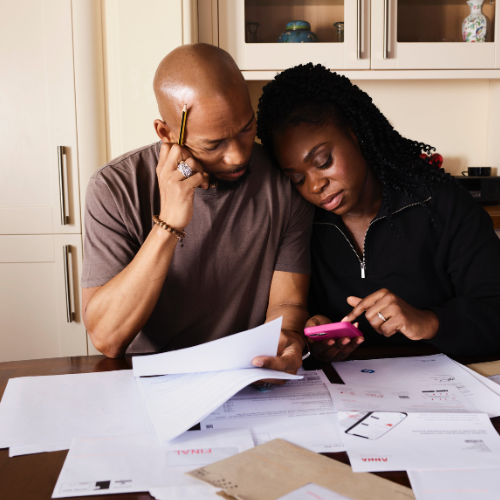The Best Way to Track Spending
Last Updated: January 25, 2024

How much did you spend on groceries last week? What is the cost for you to drive to work each day? Would you have enough extra for Notre Dame football tickets?
If you don’t know these numbers, you could benefit from tracking your spending, even if you have more than enough to cover your monthly bills. This money management method can be simple enough for anyone to do and takes mere minutes.
Why You Should Track Your Expenses
Knowing where every dollar goes each month has significant benefits. For one, you can account for everything you earn and understand if your spending choices align with your overall goals and values. Second, it's a good way to notice things like fraudulent charges on credit cards or subscription fees you didn’t remember you were paying.
By tracking expenses, you can control your money and make it work for you.
What is the Best Way to Track Spending
Because money matters are personal, the method you choose to monitor spending may differ from another person's choice. Some people are largely hands-on, wanting to type things into a spreadsheet so they can study every penny. Others like the conveniences of today's budgeting apps and digital spending trackers, which automatically import all spending transactions from credit cards and bank accounts into one convenient view. This allows them to see what's going on without the additional work of entering each expense.
The best method is the one that you will actually use and continue using throughout your lifetime. You may try one for a bit and move on to something else; that’s OK. Just be sure you are keeping tabs on all your money in some form.
How To Track Your Spending

Are you ready to try it? It may seem overwhelming if you’ve never tracked your expenses before, especially if you have multiple accounts or make numerous purchases in a day. Don’t feel you need to go back through years of records. While many digital budgeting tools will import historical data from a year or two ago, it’s not always an option.
Just start with today and move forward.
1. Keep an Open Mind
Many people avoid tracking their spending. If there are issues paying bills or not having enough money for fun luxuries, a person may know they could do a better job of managing their money. Tracking spending sheds light on those issues, which may cause people to feel regret.
But this is a sign of responsibility and growth. Even if you don’t like what you see in your spending patterns at first, you can’t do better without the knowledge of the past. Tracking your spending and acknowledging the improvements you could make is something to be proud of — you can do this!
2. Account for All Spending
The next step involves gathering spending information from all sources. This means checking and savings accounts, credit and debit cards, investment accounts, and even cash. If you bought something with it, include it.
This part can take time because some accounts may be rarely used. But even investment accounts and other financial vehicles charge fees, and you’ll want to monitor these, too. Be sure to track down every cent spent.
3. Break up Your Expenses into Buckets
With your big list of expenses for the previous month acquired, go through it and assign each charge a label, or a bucket. This may seem daunting, but the help of a budgeting app can make it go quickly. Place all expenses into buckets like utilities, housing, food, and automobile – then break them up even further if some buckets are too big. For example, the automobile bucket can be broken down into loan payments, maintenance, and gas. This is essential for seeing trends in your spending and truly understanding where your money goes.
4. Review Spending
Now review every spending category, or bucket.
Were you surprised at what you found? Were your groceries higher for the month than you expected? Were there a few subscription charges you had forgotten about? What stuck out to you as different than what you imagined your financial situation would be?
Any expenses that were higher than you expected or unnecessary should be reviewed carefully to determine if future changes can be made in your spending habits.
Some changes, such as canceling that forgotten-about streaming service, can be made right away. Others, such as paring down the amount you spend on groceries, will have to be done over time.
5. Set New Goals
With an honest look at how you’ve been doing, where do you see yourself in a month, six months, even a year? If it’s putting more money into your savings account or stashing more cash for a down payment on a home, these wishes should be reflected in new goals. Set up a budget that reflects these goals, with concrete amounts for each spending category. Try to make them attainable. Don’t, for instance, try to cut your grocery bill in half the first month. Instead, try to trim by 5-10% and see how you do.
If you can, create a mix of short-term and long-term goals. For example, you could try setting a short-term goal of putting $20 in an envelope each month to share with a favorite charity, and as a long-term goal, you could place $250 in a savings account for a down payment on a home in Valpo.
If a goal is important to you, ensure it has a place in your future spending plan.
6. Review and Adjust
Each month, go over all your expenses again. How did you do? Are there any changes you can make to improve your spending habits?
The best part of budgeting is that it can change with you. With an eye on every spending action, you can be better informed and make a lifestyle plan that reflects your values, goals, and personality.
Track Your Spending With Centier Bank
At Centier Bank, you are in control of your finances. To see how we can help you better track your spending and set savings goals, check out our money management toolkit.

